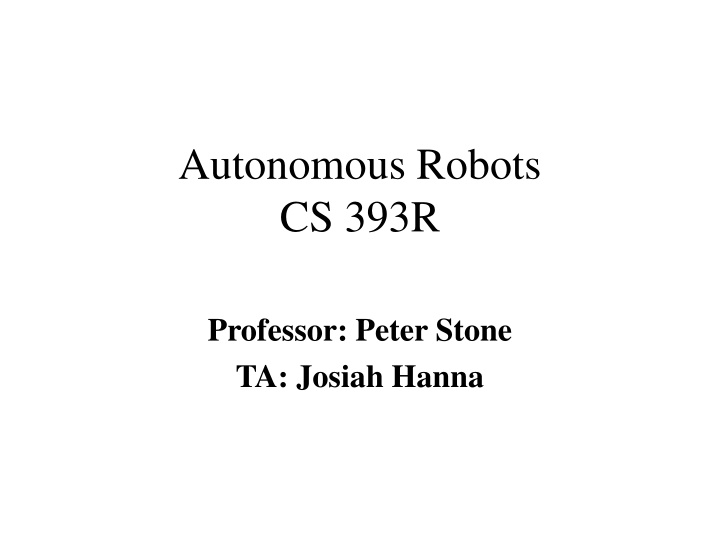
Exploring Autonomous Robots in CS 393R with Peter Stone and Josiah Hanna
Delve into the world of autonomous robots with Professor Peter Stone and TA Josiah Hanna in the CS 393R course. Learn about robot sensors, effectors, environment interaction, and the essential elements of a good model. Discover how robots function in human environments and the methodologies involved in implementing interactive loops.
Download Presentation

Please find below an Image/Link to download the presentation.
The content on the website is provided AS IS for your information and personal use only. It may not be sold, licensed, or shared on other websites without obtaining consent from the author. If you encounter any issues during the download, it is possible that the publisher has removed the file from their server.
You are allowed to download the files provided on this website for personal or commercial use, subject to the condition that they are used lawfully. All files are the property of their respective owners.
The content on the website is provided AS IS for your information and personal use only. It may not be sold, licensed, or shared on other websites without obtaining consent from the author.
E N D
Presentation Transcript
Autonomous Robots CS 393R Professor: Peter Stone TA: Josiah Hanna
Robots Slides Courtesy of Benjamin Kuipers
What is a robot? A robot is an intelligent system that interacts with the physical environment through sensors and effectors. Robot sensors effectors Environment Program module? Web crawling bot?
Slide by Manuela Veloso (on web)
Is a human a robot? By our definition, yes. Humans interact with a complex physical environment via sensors and effectors. We are not artificially manufactured, of course! Does this diminish humans? No! Understanding the difficulties of robotics helps us appreciate how amazing humans are.
We will study robots that function in (mostly) unmodified human environments. (Well, in soccer fields, anyway.) that use, and perhaps even learn, useful models of the environment. They have knowledge, and act on it.
What makes a good model of the environment? A good model is a simplified description of the environment such that If the robot orients itself in the model, and makes a plan using the model, and executes that plan in the real environment, then the plan has its intended effect.
What will we do in this course? Our goal is to learn some methods for implementing this interactive loop. Robot sensors effectors We will spend a few weeks each on topics that often get entire graduate courses. Environment
Subject Material Areas Sensing and Perception (perception) Range sensing, vision, filtering, sensor modeling, Motion and Control (action) PID control, open/closed loop control, action modeling, walking, ... Decision Making (cognition) Behavior architectures, planning, AI, developmental psychology, ...
Major Topics and Projects What is robotics? Vision Control theory Observers and tracking Localization Behavior Applications Social implications Hello, World! (9/7) Vision (9/19) Motion control (10/3) Kalman filter (10/10) Localization (10/24) Behavior (10/31) Final projects (12/12) Proposal (10/17) Literature survey (11/14) Demonstration (12/4,6)
Robot Lab Assignments Six robot lab assignments. Due roughly every 2 weeks (sometimes 1 week). You demonstrate the techniques taught in class. In theory, there s no difference between theory and practice, but in practice, there is.
What Assignments Require The point of the assignments is to implement the methods taught in class. To turn in an assignment: Demonstrate the behavior to Josiah before the due date. Each team hands in a clear, concise memo describing the problem, your approach, and your results. Append the code. The memo describes the role of each individual on the team in accomplishing this assignment. We will discuss each assignment in class on the due date. Some teams will be selected to demonstrate the robots. No assignments accepted after that class meeting.
Robot Assignments 1 - 6 Students will work in teams. Each team has 2 or 3 people. A single grade for each team. Each team has one physical robot a Nao. These are expensive, fragile! Take care of them!
The robot: Nao 25 DOF 2 cameras, 4 microphones, sonar, IR, ... Voice synthesizer, speakers, LEDs Intel ATOM 1.6ghz CPU linux
Shooting and Blocking Past year's example videos...
Working in Teams One of the goals of this course is to give you experience at working in teams. Your team can be stronger than any one individual, but it is also vulnerable. You are responsible for working effectively with your team not just for doing your own job, but also for helping the team work well together.
Grading Reading responses Due day before class (10%) Robot Assignments Hello, World! (5%) Vision (9%) Motion (9%) Tracking (9%) Localization (9%) Behavior (9%) These are never accepted late! Projects (30%) Proposal Literature Presentation Report Participation (10%)
Final Projects Research one topic in greater depth. Select a research goal (suggestions to be provided). Survey the related literature. Implement a prototype system and/or experiment. Describe in detail what you did, how it worked out, what alternative approaches were. Possibly prepare you for joining UT Austin Villa.
Syllabus overview Official syllabus is online
This class is a lot of work. Robotics includes many different concepts. Control theory, logic, probability, search, etc. Abstraction barriers are very strong in most of Computer Science, but weak in Robotics. Programs are vulnerable to sensor and motor glitches. Plan ahead, to put the time in to this course. Your team will be depending on you.
Robotics The topic is fundamentally important scientifically and technologically. Building intelligent agents Modeling the phenomenon of mind It will be very demanding on all of us. Be prepared, and start work early. First assignment: Join and post on piazza TODAY! It s also very exciting and lots of fun! Read and react to vision readings by Mon. Get started with robots!
